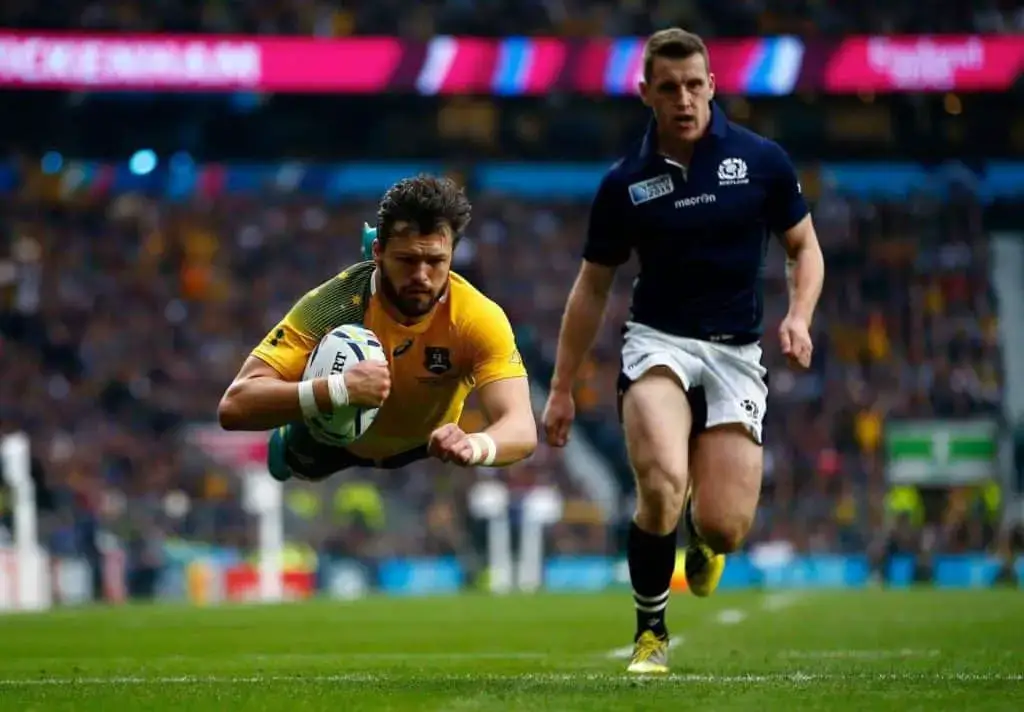Last Updated on October 27, 2023 by Alex PT
Rugby players dive to score tries. In professional rugby, a try is worth 5 points, and diving increases the chances of crossing the try line, as players can reach the goal area more quickly. It’s a strategic move in the game.
Why Do Rugby Players Dive To Score?

Rugby players dive to score tries for several reasons, rooted in the game’s rules and strategy:
- Scoring Method: In rugby, a try is a fundamental way to score points. A try is worth 5 points, and it is the primary method of advancing the scoreline.
- Crossing the Try Line: To score a try, a player must carry or ground the ball over the opponent’s try line. Diving can help a player reach the try line more quickly and effectively.
- Evasion and Defense: The opposing team’s defenders often strive to prevent a player from crossing the try line. Diving can enable a player to evade tackles and defenders, increasing their chances of reaching the try line.
- Strategic Advantage: Diving is a tactical move in rugby, utilized to outmaneuver the defense and seize opportunities to score points. Players must make quick decisions on when to dive and when to use other techniques.
- Momentum: Diving can help maintain a player’s forward momentum while carrying the ball, making it harder for defenders to stop their progress.
- Avoiding Touch: In some situations, players may need to dive to avoid being pushed into touch (out of bounds), ensuring they remain in play and have a chance to score.
- Grounding the Ball: To officially score a try, a player must ground the ball with downward pressure over the try line. Diving can facilitate this action and secure the points.
Good Technique When Diving To Score
Diving to score in rugby requires precise technique to ensure a successful try. Here are the key elements of a good diving technique when trying to score in rugby:
- Timing: Proper timing is crucial. The player should initiate the dive when they are close to the try line and confident they can cross it before being tackled. Timing ensures that the player can reach the try line before the defense can prevent them.
- Ball Control: Maintain control of the ball throughout the dive. The player should cradle the ball securely in their arms, preventing it from being dislodged or knocked forward during the dive. Keep the ball close to the body to minimize the risk of turnovers.
- Low Center of Gravity: Lower the body’s center of gravity to increase stability during the dive. Bend at the waist and knees while keeping the back straight. This posture helps with balance and control while diving.
- Extended Reach: Extend the leading arm toward the try line, reaching as far as possible to ensure that the ball crosses the try line with downward pressure. The extended arm helps to maximize the chances of scoring before being tackled.
- Eyes on the Prize: Keep your eyes fixed on the try line. This visual focus helps the player maintain a straight path and accurately gauge the distance to the try line, improving accuracy during the dive.
- Dive Low and Forward: Dive low to the ground to minimize the chances of being tackled before reaching the try line. Dive forward, maintaining momentum, and minimizing the risk of being pushed out of bounds or losing ground.
- Balance and Stability: Maintain balance during the dive by spreading the legs slightly. This prevents a loss of control or being knocked off course by defenders. Balance also helps in grounding the ball with downward pressure.
- Safe Landing: After scoring, ensure a safe landing to protect oneself from injury. Roll to the side or absorb the impact with a controlled fall to prevent injury to the head or neck.
- Practice: Repeatedly practicing diving techniques under various game situations is essential for mastering this skill. Players should develop muscle memory for proper execution.
- Decision-Making: Diving is a strategic choice. Players must decide when to dive and when to use other methods of scoring, depending on the circumstances and the positions of defenders.
Penalty Try
The referee has the power to decide a penalty try in the game of rugby. If he sees that the defending team’s misconduct has prevented a try, he has the power to award a penalty try to the attacking team in both rugby league and rugby union. Regardless of where the offense took place on the pitch, penalty tries are usually given under the posts. The referee applies the standard that a try “probably” would have been scored in rugby union. The referee does not necessarily need sure certainty that a try would have been scored.
However, in rugby league, if the referee notices that the unfair play of the defending team has led to a try-scoring success, he may then award a penalty try in his opinion in the rugby league. In rugby union, seven points are awarded to the attacking team from a penalty try, with no conversion being attempted. However, in rugby league, eight points are awarded to the attacking team from a penalty try if as the ball is being ground, the defending team makes an unfair play.
After the “try” has been awarded, the next thing is a conversion attempt, just in line where the attacking team scored a try, and then lastly, from in front of the posts, a penalty kick would be taken. After a try has been scored, any foul play results in the award of another penalty awarded on the halfway mark in rugby union. An eight-point try and a penalty try are two distinct results with the 8-point try being scarcely seen in the present rugby game.
Conversion
In both rugby league and rugby union, the attacking team which is the scoring team gets the opportunity to attempt a conversion when a try is scored. This conversion means a free-kick at the goal to modify the try from a set of points into a bigger set of points. At any point on the field of play in line, the kick is taken parallel to the touchlines with the point that the ball was grounded for the try. Extra points are scored if the attempt is successful.
However, the ball must pass between the uprights and over the crossbar for the conversion to be successful. The two ways through which the conversion can be attempted is either a dropkick or a place kick (from the ground) in both codes. The place kick is the most preferred option of conversion by most rugby players. This is because generally the place kick is regarded as an easier skill than the latter. Most attacking players usually try to ground the ball very close to the in-goal area center to make the conversion easier.
Rather than losing the ball when trying to pass it to a teammate or by being tackled, most attackers used to quickly ground the ball immediately after they were confronted by an opposing defender. Generally, a conversion is worth two good points in both rugby league and rugby union. However, a five-point try is converted to seven by a successful kick at a goal in rugby union, whereas, in rugby league, a successful kick at a goal converts four-point try to six.
Why Do Rugby Players Slide?
Both in rugby union and rugby league, rugby players, in the attempt to score a try, slide into the in-goal area. To reduce the chances of losing the ball or being interrupted, a rugby player needs to maintain the ball’s distance to the ground if the ball is inches away from the ground when he wants to enter the in-goal area.
Does The Ball Have To Touch The Ground In Rugby?
Yes, of course! The ball has to touch the ground in rugby especially when an attacking player is attempting a try. That’s because a try is only scored by grounding the ball in the in-goal area of the opposition which is on or behind the goal line. In-goal area and grounding the ball have slight differences in rugby union and league.
Aspect Common To Both Union And League In Terms Of Making A Try
Honestly, between the two codes of rugby, there are differences in the fine details of the laws and their interpretation. The ball itself and the player holding it must never be touch-in-goal or touch, not excluding over or on the dead-ball line. The points that are counted as being “out” in the game of rugby include touch-in-goal lines, deadball lines, and touchlines. For the ball to be ruled in touch-in-goal or touch, there must be contact between the ground and the ball with the player.
Variations Specific To Rugby Union
There are two ways through which a rugby player can ground the ball; he can ground the ball if he holds the ball in his hands or arms, and then touches the ball to the ground or he can ground the ball if the ball with downward pressure from upper body, hands, even arms are required, is on the ground in-goal. So, for a try to be awarded, a defending player must not ground the ball before an attacking player. A five-meter scrum is awarded to the attacking team if there is uncertainty about which team had grounded the ball first.
A player who’s in contact or even touch-in-goal, but who’s not holding the ball, might mark a try by grounding the ball in goal. The goalposts and padding at ground level are included in the goal line and thus of the in-goal, therefore a try might be scored by grounding the ball in the feet of the posts.
A try is scored in case an attacking player is tackled light of the goal line but quickly gets out and also puts the ball on and over the goal line. (This is an immediate contrast to rugby league, which could award a penalty for “double movement”, see below. There’s sometimes confusion among players and spectators at community amounts of the game as well and an incorrect protest of “double movement” is a typical one at English rugby union matches. Rather compared to arms only, a “double movement” in rugby union consists of action of the torso.)
Final Words
Once again, rugby players dive because it’s the easiest and quickest way to get the ball down over the line. A “try” in the game of rugby is the method of getting points accredited by the rugby league football and rugby union. When a rugby player grounds the ball in the in-goal area of the opposition, it’s called a try in rugby. We’ve come to the end of the article, hope you were able to get resources in your quest to know why rugby players dive. Please do not hesitate to ask any questions or comments. Thanks!
References:
https://rugbydome.com/rugby-players-dive/
https://www.quora.com/Why-do-rugby-players-slide-into-the-endzone

Hi! I’m Alex PT. I hold a Bachelor’s degree in Sports Management from Indiana University and have over seven years of valuable experience working in a Sports Event Management Company. I founded SportBlurb with the passion for bringing you the latest, most insightful, and engaging content in the world of sports. So, whether you’re a die-hard fan or want to stay informed, I’ve got you covered!

